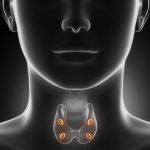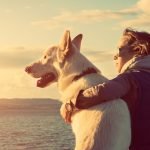The Healing Power of Love: The Hormone, Oxytocin
Heather Wdowin, NMD
Recent explorations of the posterior pituitary hormone, oxytocin (OT), have revealed much more about this hormone that is associated primarily with childbirth and breastfeeding. OT is socially, neurologically, immunologically, and cardiovascularly active, integral to metabolism and body structure maintenance, and is interwoven with the hypothalamic-pituitary-adrenal (HPA) axis and sex hormones.
OT and vasopressin are peptide hormones secreted by the hypothalamus through the neurohypophysis, but they are also neuromodulators of brain activity. Neuromodulation differs from conventional neurotransmission in that it does not simply excite or inhibit; neuromodulators may be secreted by dendrites to alter the synapse and attenuate neurotransmission.1 Neuromodulation by OT is directed towards maintaining the social group by increasing empathy, trust,2 in-group preference, and memory of socially relevant cues; it enhances affiliative prosocial behaviors, supports ovulation, parturition, lactation, sexual behavior, social interactions, and suppression of food intake.3 OT affects social performance by attenuating stress, and it regulates cooperation and conflict within intergroup relations.4
Oxytocin & Bonding
Oxytocin’s role in promoting healthy children involves more than just pushing them out and feeding them; construction of the consciousness of a human is a dance between nature and nurture in which OT plays a pivotal role, and one not entirely due to breastfeeding, as infant salivary OT levels also increase with positive paternal attention.5 Positive social interaction with caregivers is the basis of “secure attachment” and is an integral part of the social human psyche. OT supports sensitive caregiving3; levels of OT rise when a mother holds her child, and later when bonded people see, hear, or even think of each other.6 Securely attached parents have higher baseline OT and a more pronounced OT response to interactions with their children. According to Legros,
These neurobiological influences promote responsive, affectionate caregiving, which in turn promotes OT activity in children, along with child attachment behaviors that further engage parental brain systems, resulting in a positive feedback cycle that culminates in a mentally healthy, securely attached child.
(Legros JJ, 2001)3
The effects of nurturing a child early in life can be long-lasting, and help to maintain and develop social behavior and bonding in adulthood.7 Alternately, early life stressors change a person’s stress reactivity by decreasing the connection between the amygdala (generally the fearful, emotional brain) and the prefrontal cortex (where we explain to our amygdala why we shouldn’t completely freak out). Normally, OT mediates between the amygdala and prefrontal cortex and attenuates the responses to psychosocial stress; early life stress, however, dysregulates this connection.8 Most concernedly, early life trauma – especially emotional abuse – blunts the ability of oxytocin to mitigate the effects of social stress, which results in higher levels of anxiety throughout life.8
A derangement of the OT system can lead to physical and psychological ailments, including higher levels of anxiety, depression, and stress,9 in addition to an increased risk of pain and inflammation.10 Low levels of OT have been demonstrated in individuals with borderline personality disorder, certain types of depression, schizophrenia, fibromyalgia, and recurrent abdominal pain in children.6 In addition, previous experience of traumatic events is associated with an increased incidence of low OT levels or stress-related reduction of OT levels.6
Infants who were closely monitored and responded to by a caregiver show increased OT in their saliva compared to infants who were not.11 Early life is a vital period for healthy development in humans, with OT being an important regulator of emotional development. Our first relationships determine how our brains our hardwired to respond in social and stressful situations,11 and “it is important to acknowledge that the oxytocin system has numerous bilateral interactions (e.g., dopamine and HPA-axis) that are likely to affect behavior. Changes to the oxytocin system will also influence these systems and vice versa.”11 Evidence from human studies indicate that an imbalance within the brain OT system plays a role in the etiology of anxiety disorders, especially those with a social component.12
Therapeutic Applications of Oxytocin
Raising intracerebral OT levels via intranasal administration of OT can increase altruism, generosity, empathy, and trust, while decreasing fear, anxiety, and stress reactions.13 Based on clinical studies, OT therapy shows therapeutic promise with the following disorders:
- Depression, anxiety, psychotic symptoms, and general psychopathology: Patients have been shown to experience a reduction of symptoms with OT therapy. The beneficial effects were moderated by frequency of administration.14
- Post-partum depression: The calming and soothing effects of OT may promote more relaxed, energetic, and infant-focused interactive behaviors in mothers with post-partum depression.15
- Sexual function: OT positively impacts libido, erection, and orgasm, and has been shown to be well tolerated.16 Men additionally indicated higher levels of sexual satiety after sexual intercourse with OT administration. Women felt more relaxed, and subgroups of women indicated greater ability to share sexual desires or to empathize with their partners.17
- Age-related muscle loss: “OT supports productive repair and maintenance of skeletal muscle… age-imposed decline in OT contributes to sarcopenia… OT acts directly on muscle stem cells.”18
- Weight loss: “Intranasal OT was administered to obese patients (BMI 30–36) at a dose of 24 IU, four times a day during 8 weeks. This treatment led to a significant and constant decrease in body weight (almost 9 kg) with a concomitant decrease in total- and LDL-cholesterol. It is noteworthy that this clinical trial was performed in male and female volunteers (pregnant and lactating females excluded) and that no adverse effect was described, reinforcing the fact that this treatment seems to be safe and effective in both sexes.”19 In men, OT administration reduced caloric intake from fat, increased levels of cholecystokinin, and shifted the metabolism from carbohydrate to fat utilization while improving insulin sensitivity.20
- Post-Traumatic Stress Disorder (PTSD) and Stress: OT inhibits ACTH secretion, and it is likely that the oxytocinergic system – via physiological and/or pharmacological manipulation – can “buffer” the stress-activated vasopressin-ACTH-cortisol response that is at the root of so many issues in our patients.3 A dose of 40 IU of OT was given intranasally to male and female PTSD patients. Results indicated beneficial neurobiological effects of OT administration in patients; the greater the anxiety prior to the session, the greater the reduction of amygdala reactivity (fear) after OT administration.21 In another study, OT helped restore normal function to prefrontal brain regions associated with memory and cognitive function in combat veterans.22
- Autism Spectrum Disorder (ASD) & ADD: ADD/ADHD patients have significantly lower peripheralOT levels compared with their normal counterparts, and the repetitive behavior seen in ASD is related to abnormalities in the OT system.23 Evidence shows that acute OT administration improves numerous markers critical to the social circuitry underlying social deficits in OT may optimize these circuits to enhance reward, motivation, and learning, thus improving therapeutic outcomes.24 “Previous clinical trials of a single dose of oxytocin have consistently reported significantly positive effects on various experimental measures associated with the core symptoms of ASD.”25 Intranasal administration of 24 IU of OT increased eye contact in adult autistic subjects,26 and in children improved social cognition/function, repetitive behaviors, and anxiety.27
- Addiction: Evidence suggests that through dopaminergic, serotonergic, and endogenous opioid mechanisms, OT is involved in increasing resilience in the face of stress and addiction.28
- Male infertility: “Oxytocinpromotes the progression of the sperm and increases the conversion of testosterone into dihydrotestosterone.”29
How to Increase Oxytocin
Express gratitude: “Gratitude and its expression provides behavioral and psychological ‘glue’ to bind individuals closer together… findings suggests that the oxytocin system is associated with solidifying the glue that binds adults into meaningful and important relationships.”30
Exercise: Salivary OT levels increased 2.5-fold 10 minutes into a moderate run.31
Get a massage: OT is released by massage; stroking of the skin and repeated massage treatments are associated with long-term expression of OT’s beneficial effects.6
Give a hug: Sounds trite, but frequent hugs between loving partners are associated with increased OT levels, and decreased heart rate and blood pressure.32 Just 10 minutes of warm contact between people was related to higher OT levels in both men and women, and decreased norepinephrine levels in women.33
Take your vitamin C: The last step of the hormone’s synthesis reactions is vitamin C-dependent. Ascorbate may regulate OT secretion not only through biosynthesis, but also through interaction with catecholamines.34
Probiotics: An animal study showed that “Lactobacillus reuteri enhances wound-healing through up-regulation of [OT]… by a vagus nerve-mediated pathway; [OT] serves to activate host CD4+Foxp3+CD25+ immune T regulatory cells.35 This strain is found in several probiotics designed for women’s genitourinary health.
Have more sex: Large amounts of OT are released in response to sexual activity, including a surge of OT during orgasm. Long-term studies suggest that individuals with a good sex life are healthier and live longer, likely due to the OT release during sex. This release is thought to contribute to OT’s health-promoting effects, including a higher sex drive.6
Get a dog: Petting a dog regularly increases OT levels in both species.6 Intranasally dosing a dog with OT will increase the dog’s eye contact with their human, and increased OT levels will be found in that human as well.36 Sorry, cat people, eye contact with a cat probably means they are plotting your demise.
Avoid bisphenol A (BPA): OT function is reduced by BPA exposure, probably due to the interaction between BPA and estrogen.37
Prescription: Intranasal OT is the most studied way to administer OT outside of the delivery room. OT is broken down rapidly in the intestines, making oral dosing ineffective; however, according to my pharmacist, sublingual dosing is thought to be comparable as long as the solution is kept under the tongue to maximize absorption. Remember that many studies have shown statistically significant neural and behavioral changes with intranasal administration, even if brain levels are thought to only increase slightly.
The benefits of OT therapy have been shown to be directly related to frequency of administration.14 A study on the effects of intranasal OT on autism found that a daily dose of 0.4 IU/kg (eg, 27 IU for a 150 lb person) was well tolerated; reported side effects included restlessness, increased irritability, and increased energy.38 Most importantly, the social cognition/function, repetitive behaviors, and anxiety remained improved for 3 months after the last dose.27
Closing Comment
Although an abundance of research has been conducted on oxytocin, we are nonetheless in the infancy of understanding the full therapeutic effects of this hormone. Oxytocin may be a novel treatment option for conditions regularly seen by naturopathic physicians, particularly post-partum depression, stress and anxiety, sexual dysfunction, obesity, and autism spectrum disorder.
 Heather Wdowin, NMD, is a licensed primary care physician in the state of Arizona, where she specializes in oncology, chronic disease, endocrinology, and sports medicine; she is also a licensed NMD in California. She graduated with a bachelor’s degree in neurobiology from Cornell University in Ithaca, NY; her Doctorate in Naturopathic Medicine is from Southwest College of Naturopathic Medicine in Tempe, AZ. She is a member of the Endocrinology Association of Naturopathic Physicians, and is working on becoming board-certified in naturopathic oncology. She has studied with the leaders of the emerging Environmental Medicine field, and teaches Advanced Pharmacology for the University of Phoenix Nurse Practitioner program.
Heather Wdowin, NMD, is a licensed primary care physician in the state of Arizona, where she specializes in oncology, chronic disease, endocrinology, and sports medicine; she is also a licensed NMD in California. She graduated with a bachelor’s degree in neurobiology from Cornell University in Ithaca, NY; her Doctorate in Naturopathic Medicine is from Southwest College of Naturopathic Medicine in Tempe, AZ. She is a member of the Endocrinology Association of Naturopathic Physicians, and is working on becoming board-certified in naturopathic oncology. She has studied with the leaders of the emerging Environmental Medicine field, and teaches Advanced Pharmacology for the University of Phoenix Nurse Practitioner program.
References
- Stoop R. Neuromodulation by oxytocin and vasopressin. Neuron. 2012;76(1)142-159.
- Kosfeld M, Heinrichs M, Zak PJ, et al. Oxytocin increases trust in humans. Nature. 2005;435(7042):673-676.
- Legros JJ. Inhibitory effect of oxytocin on corticotrope function in humans: are vasopressin and oxytocin ying-yang neurohormones? Psychoneuroendocrinology. 2001;26(7):649-655.
- Shamay-Tsoory SG, Abu-Akel A. The Social Salience Hypothesis of Oxytocin. Biol Psychiatry. 2016;79(3):194-202.
- Rilling JK, Young LJ. The biology of mammalian parenting and its effect on offspring development. Science. 2014;345(6198):771-776.
- Uvnäs-Moberg K, Handlin L, Petersson M. Self-soothing behaviors with particular reference to oxytocin release induced by non-noxious sensory stimulation. Front Psychol. 2015;5:1529.
- Stoop R, Hegoburu C, van den Burg E. New opportunities in vasopressin and oxytocin research: a perspective from the amygdala. Annu Rev Neurosci. 2015;38:369-388.
- Fan Y, Herrera-Melendez AL, Pestke K, et al. Early life stress modulates amygdala-prefrontal functional connectivity: implications for oxytocin effects. Hum Brain Mapp. 2014;35(10):5328-5339.
- Julius H, Beetz A, Kotrchal K, et al. Attachment to Pets: An Integrative View of Human-Animal Relationships with Implications for Therapeutic Practice. New York, NY: Hogrefe Publishing; 2012.
- Davies K, Macfarlane GJ, McBeth J, et al. Insecure attachment style is associated with chronic widespread pain. Pain. 2009;143(3):200-205.
- Alves E, Fielder A, Ghabriel N, et al. Early social environment affects the endogenous oxytocin system: a review and future directions. Front Endocrinol (Lausanne). 2015;6:32.
- Neumann ID, Slattery DA. Oxytocin in General Anxiety and Social Fear: A Translational Approach. Biol Psychiatry. 2016;79(3):213-221.
- Mitchell IJ, Gillespie SM, Abu-Akel A. Similar effects of intranasal oxytocin administration and acute alcohol consumption on socio-cognitions, emotions and behavior: Implications for the mechanism of action. Neurosci Biobehav Rev. 2015;55:98-106.
- Hofmann SG, Fang A, Brager DN. Effect of intranasal oxytocin administration on psychiatric symptoms: A meta-analysis of placebo-controlled studies. Psychiatry Res. 2015;228(3):708-714.
- Samuel S, Hayton B, Gold I, et al. Maternal mental health moderates the relationship between oxytocin and interactive behavior. Infant Ment Health H. 2015;36(4):415-426.
- MacDonald K, Feifel D. Dramatic improvement in sexual function induced by intranasal oxytocin. J Sex Med. 2012;9(5):1407-1410.
- Behnia B, Heinrichs M, Bergmann W, et al. Differential effects of intranasal oxytocin on sexual experiences and partner interactions in couples. Horm Behav. 2014;65(3):308-318.
- Elabd C, Cousin W, Upadhyayula P, et al. Oxytocin is an age-specific circulating hormone that is necessary for muscle maintenance and regeneration. Nat Commun. 2014;5:4082.
- Altirriba J, Poher AL, Rohner-Jeanrenaud. Chronic Oxytocin Administration as a Treatment Against Impaired Leptin Signaling or Leptin Resistance in Obesity. Front Endocrinol (Lausanne). 2015;6:119.
- Lawson EA, Marengi DA, DeSanti RL, et al. Oxytocin reduces caloric intake in men. Obesity (Silver Spring). 2015;23(5):950-956.
- Koch SB, van Zuiden M, Nawijn L, et al. Intranasal Oxytocin Administration Dampens Amygdala Reactivity towards Emotional Faces in Male and Female PTSD Patients. Neuropsychopharmacology. 2015 Sep 25. doi: 10.1038/npp.2015.299. [Epub ahead of print]
- Eidelman-Rothman M, Goldstein A, Levy J, et al. Oxytocin affects spontaneous neural oscillations in trauma-exposed war veterans. Front Behav Neurosci. 2015;29;9:165.
- Sasaki T, Hashimoto K, Oda Y, et al. Decreased levels of serum oxytocin in pediatric patients with Attention Deficit/Hyperactivity Disorder. Psychiatry Res. 2015;228(3):746-751.
- Guastella AJ, Hickie IB. Oxytocin Treatment, Circuitry and Autism: A Critical Review of the Literature Placing Oxytocin into the Autism Context. Biol Psychiatry. 2016;79(3):234-242.
- Yamasue H. Promising evidence and remaining issues regarding the clinical application of oxytocin in autism spectrum disorders. Psychiatry Clin Neurosci. 2015 Sep 22. doi: 10.1111/pcn.12364. [Epub ahead of print]
- Auyeung B, Lombardo MV, Heinrichs M, et al. Oxytocin increases eye contact during a real-time naturalistic social interaction in males with and without autism. Transl Psychiatry. 2015;5:e507.
- Anagnostou E, Soorya L, Brian J, et al. Intranasal oxytocin in the treatment of autism spectrum disorders: a review of literature and early safety and efficacy data in youth. Brain Res. 2014;1580:188-198.
- Tops M, Koole SL, IJzerman H, Buisman-Pijlman FT.Why social attachment and oxytocin protect against addiction and stress: Insights from the dynamics between ventral and dorsal corticostriatal systems. Pharmacol Biochem Behav. 2014;119:39-48.
- Gulino G, Stefanucci M, Antonucci M, et al. Male infertility: non-surgical therapy. Urologia. 2014;81(3):148-153.
- Algoe SB, Way BM. Evidence for a role of the oxytocin system, indexed by genetic variation in CD38, in the social bonding effects of expressed gratitude. Soc Cogn Affect Neurosci. 2014;9(12):1855-1861.
- Jong TR, Menon R, Bludau A, et al. Salivary oxytocion concentrations in response to running, sexual self-stimulation, breastfeeding and the TSST: The Regensburg OT Challenge (ROC) study. Psychoneuroendocrinology. 2015;62:381-388.
- Light KC, Grewen KM, Amico JA. More frequent partner hugs and higher oxytocoin levels are linked to lower blood pressure and heart rate in premenopausal women. Biol Psychol. 2005;69(1):5-21.
- Grewen KM, Girdler SS, Amico J, Light KC. Effects of partner support on resting OT, cortisol, norepinephrine and blood pressure before and after warm partner contact. Psychosom Med. 2005;67(4):531-538.
- Luck MR, Jungclas B. Catecholamines and ascorbic acid as stimulators of bovine ovarian oxytocin secretion. J Endocrinol. 1987;114(3):423-430.
- Poutahidis T, Kearney S, Levkovich T. Microbial symbionts accelerate wound healing via the neuropeptide hormone oxytocin. PLoS One. 2013;8(10):e78898.
- Nagasawa M, Mitsui S, En S, et al. Social evolution. Oxytocin-gaze positive loop and the coevolution of human-dog bonds. Science. 2015;348(6232):333-336.
- Brown JS Jr. Effects of bisphenol-A and other endocrine disruptors compared with abnormalities of schizophrenia: an endocrine-disruption theory of schizophrenia. Schizophr Bull. 2009;35(1):256-278.
- Preti A, Melis M, Siddi S, et al. Oxytocin and autism: a systematic review of randomized controlled trials. J Child Adolesc Psychopharmacol. 2014;24(2):54-68.










